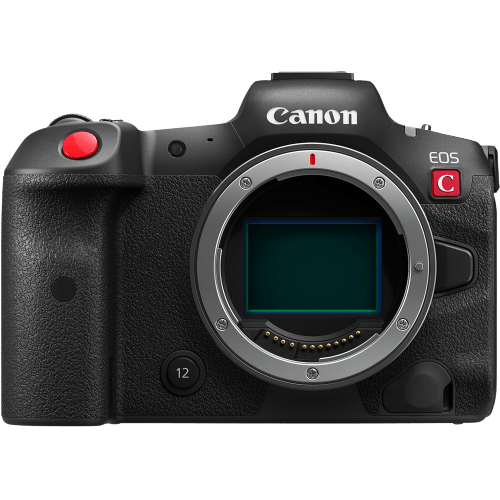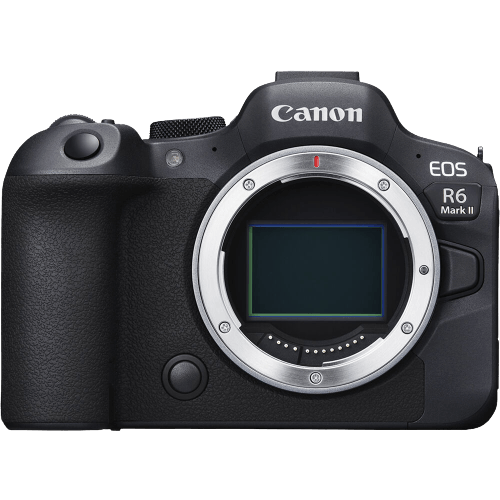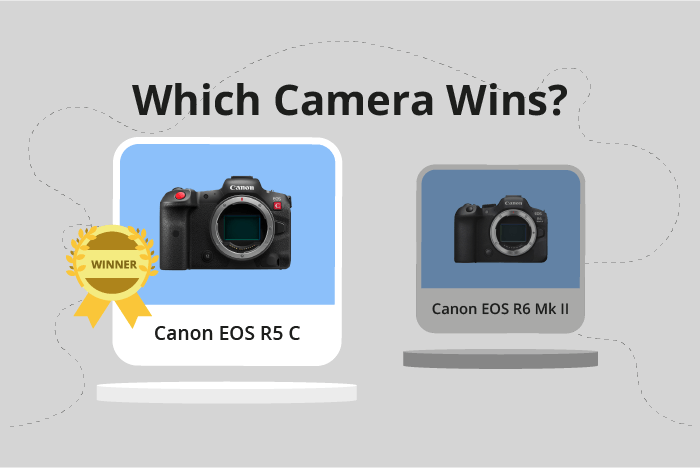Canon EOS R5 C vs EOS R6 Mark II Comparison
Canon EOS R5 C

Canon EOS R6 Mark II

The Canon EOS R5 C outperforms the Canon EOS R6 Mark II with a score of 87/100 compared to the latter’s 78/100. Both cameras share similarities as mirrorless models released in 2022, with the R5 C announced on January 19th and the R6 Mark II on February 11th. The R5 C excels with its larger size (142 x 101 x 111mm) and heavier weight (770g / 1.70lbs), providing a more robust build for demanding photographers.
On the other hand, the R6 Mark II boasts a more compact size (138.4 × 98.4 × 88.4mm) and lighter weight (588g / 1.30lbs), making it a better choice for those who prioritize portability. However, the R5 C justifies its higher launch price of $4499, compared to the R6 Mark II’s $2499, with its superior performance and build quality.
Ultimately, the Canon EOS R5 C is the better camera, offering a more solid construction and better performance, while the Canon EOS R6 Mark II caters to photographers seeking a more portable option at a lower price point.
Canon EOS R5 C vs EOS R6 Mark II Overview and Optics
The Canon EOS R5 C outperforms the Canon EOS R6 Mark II in optics, scoring 88/100 compared to the R6 Mark II’s 83/100. Both cameras share several specifications, including a CMOS sensor, Digic X processor, full-frame sensor size, Canon RF lens mount, and image stabilization. However, there are key differences that contribute to the R5 C’s higher score.
The R5 C boasts a superior 45-megapixel sensor, compared to the R6 Mark II’s 24-megapixel sensor. This higher resolution allows the R5 C to capture more detail, resulting in clearer and sharper images. Additionally, the R5 C has a higher DXOMARK score of 97 for its sensor, while the R6 Mark II scores 91. This further highlights the R5 C’s better sensor performance and image quality.
On the other hand, the R6 Mark II has a shooting speed of 40, double that of the R5 C’s 20. This faster shooting speed enables the R6 Mark II to capture fast-moving subjects more effectively, making it a better choice for action and sports photography. Despite this advantage, the R6 Mark II’s lower resolution and sensor performance ultimately result in a lower overall optics score.
In conclusion, the Canon EOS R5 C is the superior camera in terms of optics, due to its higher resolution and sensor performance. However, the Canon EOS R6 Mark II may still be a better choice for those prioritizing fast shooting speeds for action photography.
Canon EOS R5 C vs EOS R6 Mark II Video Performance
The Canon EOS R5 C outperforms the Canon EOS R6 Mark II in video capabilities with a score of 100/100 compared to the latter’s 83/100. Both cameras share some common features, such as having built-in time-lapse functionality. However, the R5 C surpasses the R6 Mark II in several key aspects.
The R5 C boasts a maximum video resolution of 8K, while the R6 Mark II only supports 4K. This significant difference in resolution, with the R5 C’s 8192 x 4320 dimensions compared to the R6 Mark II’s 3840 x 2160, enables the R5 C to produce much sharper and more detailed video footage. Additionally, the R5 C’s maximum video frame rate is 120fps, which allows for smoother slow-motion capture compared to the R6 Mark II’s 60fps.
While the R6 Mark II falls short in resolution and frame rate, it still offers reliable 4K video quality suitable for most users’ needs. Its 60fps frame rate is sufficient for general videography purposes and its built-in time-lapse functionality matches that of the R5 C.
The Canon EOS R5 C’s superior video capabilities make it the clear winner in this comparison, offering outstanding 8K resolution and a higher frame rate for slow-motion capture. The R6 Mark II, while not as advanced, still provides solid 4K video performance and shares the useful time-lapse functionality with the R5 C. Ultimately, the R5 C is the superior choice for those seeking top-tier video quality and performance, while the R6 Mark II remains a viable option for those with less demanding video requirements.
Canon EOS R5 C vs EOS R6 Mark II Features and Benefits
The Canon EOS R5 C outperforms the Canon EOS R6 Mark II with a feature score of 87/100 compared to the latter’s 72/100. Both cameras share common specifications, including touchscreen capabilities, flip screens, WIFI, and Bluetooth connectivity. Despite these similarities, the R5 C surpasses the R6 Mark II in certain aspects, while the R6 Mark II holds its own advantages.
The R5 C excels with a larger screen size of 3.2 inches and a higher screen resolution of 2,100,000 dots, compared to the R6 Mark II’s 3-inch screen and 1,620,000-dot resolution. This difference results in a more detailed and enjoyable viewing experience, enabling better image composition and review on the R5 C.
Contrarily, the R6 Mark II has GPS functionality, which the R5 C lacks. This feature allows users to geotag their photos and videos, making it easier to organize and locate media based on location data. This advantage may appeal to photographers who prioritize location-based organization or those who frequently shoot outdoors and travel.
Weighing the differences, the Canon EOS R5 C stands out as the superior camera in terms of features, thanks to its larger screen size and higher resolution. This camera is ideal for users seeking an enhanced viewing experience. On the other hand, the Canon EOS R6 Mark II caters to those who value GPS functionality for geotagging and location-based organization. Ultimately, the choice between these two cameras depends on the user’s priorities and specific needs.
Canon EOS R5 C vs EOS R6 Mark II Storage and Battery
The Canon EOS R5 C and the Canon EOS R6 Mark II both score 68/100 in storage and battery. They share common specifications, including two memory card slots and compatibility with UHS-II SD cards. Additionally, both cameras use the LP-E6NH battery type and offer USB charging.
The EOS R5 C stands out by accepting CFexpress B cards, providing faster read and write speeds for demanding tasks such as high-resolution video recording. However, the EOS R6 Mark II has a slightly longer battery life of 360 shots compared to the EOS R5 C’s 320 shots, which may be advantageous during extended shooting sessions.
Despite these differences, the storage and battery capabilities of both cameras remain on par overall. The choice between the two depends on the user’s priorities, whether it be faster memory card performance or a marginally longer battery life.
Canon EOS R5 C vs EOS R6 Mark II – Our Verdict
Are you still undecided about which camera is right for you? Have a look at these popular comparisons that feature the Canon EOS R5 C or the Canon EOS R6 Mark II:

